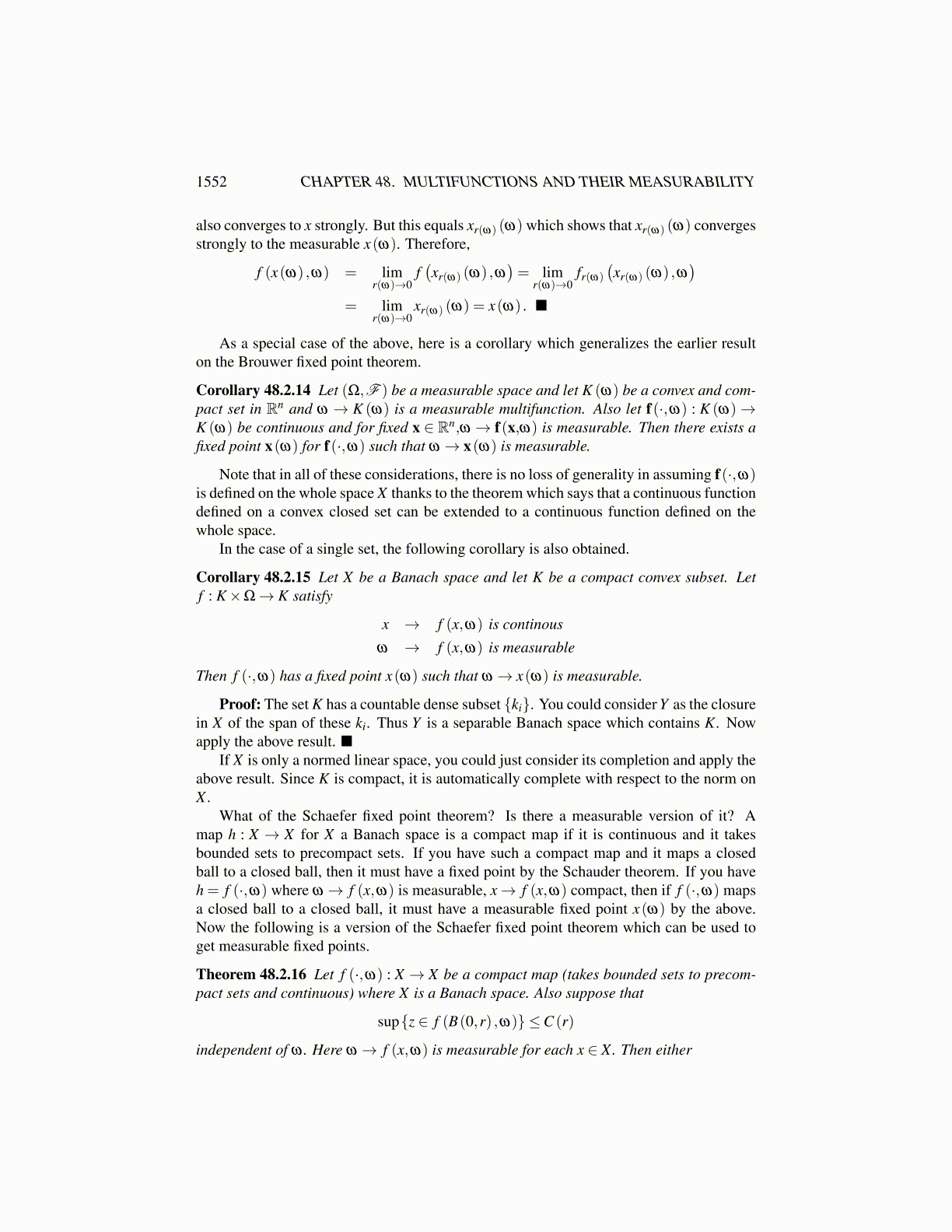
1552 CHAPTER 48. MULTIFUNCTIONS AND THEIR MEASURABILITY
Thus φ i is continuous in y and measurable in ω for fixed y. Also φ i (y,ω) > 0 if y ∈B(yi (ω) ,r) and φ i (y,ω) = 0 if y /∈ B(yi (ω) ,r). For y ∈ f (K,ω), let
ψ i (y,ω)≡ φ i (y,ω)
(n(ω)
∑j=1
φ j (y,ω)
)−1
.
From the formula, ω → ψ i (y,ω) is measurable. Also 48.2.1 is satisfied. Indeed the de-nominator is not zero because y is in one of the B(yi (ω) ,r). Thus it is obvious that thesum of these equals 1 on f (K,ω). Now let fr be given by 48.2.2 for x ∈ K (ω). For such x,
f (x,ω)− fr (x,ω) =n
∑i=1
( f (x,ω)− yi (ω))ψ i ( f (x,ω) ,ω)
Thus
f (x,ω)− fr (x,ω) = ∑{i: f (x)∈B(yi(ω),r)}
( f (x,ω)− yi (ω))ψ i ( f (x,ω) ,ω)
+ ∑{i: f (x,ω)/∈B(yi(ω),r)}
( f (x,ω)− yi (ω))ψ i ( f (x,ω) ,ω)
= ∑{i: f (x,ω)−yi(ω)∈B(0,r)}
( f (x,ω)− yi (ω))ψ i ( f (x,ω) ,ω) =
∑{i: f (x,ω)−yi(ω)∈B(0,r)}
( f (x,ω)− yi (ω))ψ i ( f (x,ω) ,ω) ∈ B(0,r)
because 0 ∈ B(0,r), B(0,r) is convex, and 48.2.1. f (x,ω)− fr (x,ω) is a convex combi-nation of vectors in B(0,r).
We think of fr (·,ω) as an approximation to f (·,ω). In fact it is uniformly within r off (·,ω) on K (ω). The next lemma shows that this fr (·,ω) has a fixed point. This is themain result and comes from the Brouwer fixed point theorem in Rn. It is an approximatefixed point.
Lemma 48.2.12 Let f (K (ω) ,ω) be compact. For each r > 0, there exists xr (ω)∈ convexhull of f (K (ω) ,ω)⊆ K (ω) such that
fr (xr (ω) ,ω) = xr (ω) , ∥ fr (x,ω)− f (x,ω)∥< r for all x ∈ K (ω)
and ω → xr (ω) is measurable.
Proof: The upper limit in the sum of the above lemma n(ω) is a measurable function.One can partition the measure space according to the value of n(ω). This gives a countableset of disjoint measurable subsets {Ωn}∞
n=1 in the partition such that on the measurableset Ωn, n(ω) = n. Specializing to the measurable space consisting of Ωn, we will assumehere that n(ω) = n and show that there exists a measurable fixed point xr (ω) ∈ K (ω) forω ∈ Ωn. Then the result follows by letting xr (ω) be that which has been obtained on Ωn.